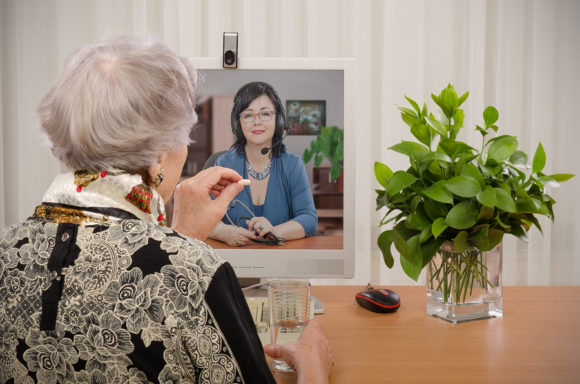The use of telemedicine may be in its nascent stages within the workers’ compensation system, but the starting line has definitely been crossed with employers and workers’ comp insurers embracing the ability to provide remote medical care to injured employees using the video technology embedded in smart phones, tablets and computers.
“Telemedicine is experiencing amazing growth. It’s extremely popular in group health now, as well as workers’ compensation. We know quantitively there’s enormous potential for future utilization,” said Dr. David Deitz of David Deitz and Associates.
Deitz, a managed care consultant, made those comments as moderator of a forum on telemedicine during the Workers’ Compensation Research Institute’s (WCRI) 35th Annual Issues and Research Conference held earlier this year.
Deitz said there’s currently a minimal amount of data regarding the use of telemedicine in workers’ comp, but it appears that usage is not as commonplace in workers’ compensation as it is in the group health setting.
There is, however, a “paradigm shift” occurring in workers’ comp when it comes to telemedicine, according to Dr. Stephen Dawkins, medical director at Cadaceus USA, an Atlanta, Georgia-based provider of medical management services in occupational health, and a member of the WCRI telemedicine panel. That paradigm shift is a “huge thing that we’re all going through whether you are the patient, the employer, whatever the case may be.”
The use of telemedicine in workers’ comp has multiple advantages, according to both Deitz and Dawkins. It breaks down geographical barriers — it can be used in both rural and urban settings, and the injured employee receives treatment at the workplace, allowing for near-immediate return to work if appropriate.
AF Group, the parent organization of a group of workers’ comp carriers that together provide coverage in all 50 U.S. states, took the plunge several years ago and began offering telemedicine services to its policyholders. The program has been well received, according to Dr. Dan Hunt, medical director for AF Group, who told Insurance Journal he expects the use of telemedicine will become “very standard within the workers’ compensation industry” in the coming years.
Similarly, Dr. Dinesh Govindarao, medical director at State Compensation Insurance Fund (SCIF) in California, which also offers policyholders a telemedicine option, said it’s likely the industry will see a surge within the next three to five years.
“There’s so much opportunity with it. What we’ve been finding is when people actually go … this route, they actually are very pleasantly surprised and want to continue [using it] when it’s appropriate for the care that they need,” Govindarao said.
In late 2016 when AF Group’s Hunt and his colleagues began exploring how to provide telemedicine services to policyholders, there really were not a lot of options available. In fact, he said, he got the sense talking to other people in the industry that telemedicine might not be right for workers’ comp.
What AF Group found were vendors that offered nurse triage services, with nurses on call that could consult with the injured worker to determine whether the injury was severe enough to necessitate a visit to a brick and mortar clinical setting such as an urgent care center or an emergency room. If not, the nurse counseled the worker on self-care for the injury.
Other vendors offered a similar service, only the call went directly to a physician who then helped the employee determine the extent of the injury and if it should be treated in a clinical setting.
AF Group was interested in giving the injured worker and his or her employer a broader choice and began working with vendors that were able to fulfill the organization’s needs.
“The program that we’re involved in starts with a phone call that goes to a nurse,” Hunt said. That nurse “is trained in acute injury, more like an emergency room nurse than a workers’ compensation nurse.” The nurse talks to the injured employee to determine what the injury is and whether it is “something that the nurse can work with the individual and manage the care.”
If that’s not the case, the nurse will decide, using national guidelines, whether the injury needs to be seen by a physician. Then, “the option that the nurse helps the injured person work through is — is this something that can done as a virtual visit, with the iPad or the iPhone?”
It’s up to the employee whether to go the televisit route or to a traditional brick and mortar facility, “which might be either a doctor at a clinic or even the emergency room depending on the level of severity of the injury,” Hunt said.
Obviously, not all injuries — such as severe or life-threatening ones — would be referred for treatment via telemedicine, Hunt says. But care for strains and sprains, cuts and minor scrapes, which make up the bulk of claims among injured workers, can be appropriately managed within the telemedicine program. In fact, he says, the spectrum of injuries that have done well within the program has been broader than anticipated.
“It’s always an option for the injured worker, but we offer them the opportunity to do a televisit with a physician who’s trained in occupational injury if that’s appropriate for their level of injury. If they choose to do it, we help facilitate that,” Hunt said. If the injured worker prefers an in-person visit, “then we help facilitate them seeing someone … in a brick and mortar clinic, a typical way you might receive care.”
At first, SCIF’s telemedicine program was primarily available to employers in rural areas of California, where access to brick and mortar care facilities is limited. The carrier has now expanded availability to include all areas of the state, whether rural or urban. And it recently partnered with telehealth services provider, Kura MD, to allow injured workers access to care 24 hours a day, seven days a week.
“When we went on this mission to introduce telehealth services, we were looking at trying to fill some of these gap areas. What I mean by gap areas — it’s where there’s not really good access to medical providers. We thought that this would be another resource, another avenue for folks to have access to care in a way that they could do it on their own phone, tablet computer, laptop, rather than travel 100 miles to go see a doctor,” Govindarao said.
The company has since come to understand that the program can offer so much more to injured workers than originally thought. While it is useful for the injured workers’ initial treatment, televisits can also be used for follow-up appointments and even in some cases for post-op visits, Govindarao said.
He said SCIF looks at the advantages of telemedicine not only in terms of access to care — and it sees that aspect as being hugely beneficial — but also in terms of efficiency. “From an efficiency perspective, even if there’s a clinic down the street, the thing is that individual or that patient will drive over there, check in, wait for the doctor to see the patient and get checked out. That whole process can also be reduced from a time perspective,” Govindarao said.
Cost Savings
There’s also a potential cost savings for employers, Cadaceus USA’s Dawkins said. “On the cost side, and there needs to be more emerging data on this, but it’s clear that my clients are saving 50 percent on their workers’ comp costs. A huge, huge, huge cost savings.”
Take the case of an employee who might have suffered what is thought to be a back injury, Dawkins said. When he sees that patient in his office, “we’re probably going to do a lumbar x-ray,” Dawkins said. In telemedicine, that’s not immediately available but the quality of care can be just the same as a patient would receive in his office.
“I can’t do an x-ray, yet, on the phone, but that’s probably coming too,” he said. If it’s determined at the initial telemedicine visit that an x-ray or MRI is needed, they can be ordered. But by simply not using radiology as a matter of course in the initial telemedicine visit, “the cost savings are dramatic. That’s just with radiology,” Dawkins said.
“As a carrier, we’re not really interested in finding the least expensive provider or the least expensive physical therapist, we would like to find the ones who do a really good job, that are really good at treating work related injuries,” Hunt said.
With telemedicine, the worker has immediate access to care and therefore the healing process can begin more quickly than if the treatment is extended due to wait times or distance concerns.
“The worker gets better so much quicker and that ultimately drives down the cost of their medical care,” Hunt said.
According to Nicole Sikora, manager of Telemedicine Programs for AF Group, the savings comes with reduction in lag times and the ability to more quickly get the injured worker “to the appropriate physician as opposed to going to the ER and they run a bunch of scans. It really starts with the nurse triage and recommending the appropriate level of care for the injured worker.”
The physicians in the telemedicine program are “specifically trained in work related injuries so they understand them. They know how to treat the injured worker versus waiting two, three or longer weeks before somebody can figure out how to help them,” she said.
The Cheesecake Factory
Kurt Leisure, vice president of risk services for California-based The Cheesecake Factory, said his company began experimenting with telemedicine for addressing workplace injuries in February 2018.
Speaking as a member of the WCRI panel on telemedicine, Leisure explained that his company, which has more than 40,000 staff members and 214 full-service restaurants in 41 states and Puerto Rico, as well as 18 restaurants licensed internationally, is still in the process of determining the effectiveness of its telemedicine program.
However, benefits for both the staff and the company are apparent, he said. For the injured employee, “there’s no waiting room, there’s no four-hour emergency waiting room; they have the option. They can either go to the emergency room or they [can take advantage] of the telemedicine program. They are the ones that decide.
“For the company, the 24-hour/seven day a week model works nicely for us as well. We really have people in our restaurant 24 hours a day. They’re cooking, they’re prepping, they’re cleaning. So, 24-hour a day accessibility is huge for us.”
At The Cheesecake Factory, it works this way: If an employee gets injured in the workplace, it’s first determined whether emergency care is needed. If so, the employee is taken to an urgent care center. If it’s a non-urgent injury, the company facilitates a call into nurse triage. If the nurse triage is unsuccessful in sufficiently treating the injury, the employee is given the option of a physician visit via telemedicine, using the employee’s own mobile device.
Leisure said not all injured employees for whom telemedicine is applicable readily accept its use. Some of the most hazardous jobs in the company are those involving kitchen staff and those employees often do not speak English as their primary language. As a group, they have been more reluctant to embrace the program than, say, the front of the house servers for whom English is their primary language. “They’re all on Facebook and social media … they’re all for it. They love the telemedicine option,” he said.
He feels like it will just be a matter of time before more staff members become comfortable with the program, even the reluctant dishwasher whose English is not so good. One of the upsides for non-English-speaking staff is that with telemedicine, “we can find a bilingual doctor, speaking their language, [who] understands their culture. You don’t always get that in the emergency room for sure,” Leisure said.
Other advantages the company has found include no cost for transporting an individual to a brick and mortar setting, staff can use their own mobile devices, and delay in return-to-work is minimal.
Privacy is an issue, so the company must ensure that private spaces are available to employees in which to conduct their televisit. Also, Leisure said, it’s really important that the handoff between the nurse triage and the consulting physician goes smoothly.
In 2018, Leisure said, 3,336 calls were made to the company’s nurse triage account. Of those, just over 1,000 were successfully treated by the nurse. Of the remaining injured employees, 470 were offered telemedicine and 326 accepted. The outcomes of 188 of those were successful and no further treatment was necessary. As a result of the telemedicine use, the company saw a hard dollar cost savings of $153,000 in 2018, he said.
Challenges and Concerns
The use of telemedicine in the workplace does have challenges, according to Deitz. They include language and cultural barriers; age and societal attitudes; privacy and employee trust issues; and regulatory and reimbursement issues to work out.
Physicians involved in providing telemedicine services have to be licensed in the states from which the televisit originates. For instance, a worker might get injured in California and call into the telemedicine provider from his workplace there, while the treating physician might reside in Nevada. That physician, however, must be licensed in California in order to provide care to the injured California employee. That not only helps resolve jurisdictional issues, should a dispute over care arise, it’s also a requirement that most, if not all, states impose upon telemedicine providers.
Kim Haugaard, senior vice president of Policyholder Services at workers’ comp carrier, Texas Mutual Insurance Co., said some of his company’s concerns with telemedicine center on the practicality of how it is being “delivered to injured workers, such as: does the provider have the technical capabilities to effectively offer telemedicine? At what stage of an injury is telemedicine no longer appropriate and conventional evaluation and treatment being appropriate?”
Cost issues are also of concern to the carrier, which only operates in Texas. The state “has a telehealth parity law (payers have to reimburse for telemedicine in the same way as in-person services); however, workers’ compensation network arrangements allow for negotiated contract pricing. The question becomes one of should services delivered via telemedicine cost the same as those services which are delivered in a conventional setting, which is what we are seeing early stages of telemedicine adoption, or should there be a lower fee structure for telemedicine services?” Haugaard wrote in an email to Insurance Journal.
With telemedicine, the potential for fraud, over-billing and over-treatment is actually diminished in the view of both SCIF’s Govindarao and AF Group’s Hunt. That’s largely because the treating physicians who work for telemedicine vendor providers are known entities, and televisits are monitored and audited to make sure the injured worker received care appropriate to the injury.
While the treating physicians can write prescriptions and make arrangements for services like physical therapy, they cannot prescribe opioid medications, thus reducing the risk of prescription drug abuse.
“I would think there’s probably less fraud. Because it’s something easier to track than if the injured employee goes to the doctor’s office,” Govindarao said.
For Hunt, the reality is that “this system is safer from fraud issues than with an injured worker who doesn’t really know where to go [and] ends up visiting a physician maybe they saw on a billboard or one their friend went to, or something like that.”
Future Vision
Currently, adoption is “quite low” among Texas Mutual’s policyholders, Haugaard said. However, “we believe telemedicine will gain significant traction in the workers’ comp space and become a more prominent medical care delivery mechanism for low severity claims.”
An expansion in the use of telemedicine will particularly help injured workers in rural areas, as they will benefit from “greater access to quality medical care via telemedicine, which may increase customer satisfaction for injured workers and policyholders,” he said.
Hunt said he thinks within a couple of years telemedicine will be “standard within the workers’ compensation industry,” due to the opportunity to eliminate geography as a factor in delivering care to an injured worker and the ability to provide faster access to care.
“I think it’s going to become more sophisticated, more acceptable, more available across the country. The other thing I think you can start to see [is] physical therapy done through virtual formats if you will. … I think we’re going to continue to see this expansion of utilization of the telemedicine platform for delivering [care for] a whole host of injuries,” Hunt said.
Govindarao likened it to the technological evolution between the clunky dial-up modems that once provided access to the World Wide Web to the ubiquitous wifi internet access that is widely enjoyed today.
“I look at telemedicine evolving,” he said. “As people get used to using their smartphones and their tablets and all that, having that kind of access, they’re going to see the value of this.”
Was this article valuable?
Here are more articles you may enjoy.



 NYC Mayor Mamdani Widens Delivery-App Crackdown With Lost-Pay Lawsuit
NYC Mayor Mamdani Widens Delivery-App Crackdown With Lost-Pay Lawsuit  Battle Between Applied Systems and Comulate Escalates With New Antitrust Lawsuit
Battle Between Applied Systems and Comulate Escalates With New Antitrust Lawsuit  Thumbs Down on SELF DRIVE Act as Written, Says Industry Trades
Thumbs Down on SELF DRIVE Act as Written, Says Industry Trades  Grandson Not Covered Under Grandma’s Home Insurance
Grandson Not Covered Under Grandma’s Home Insurance 


